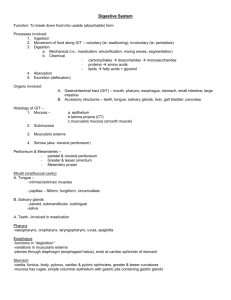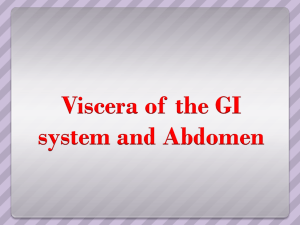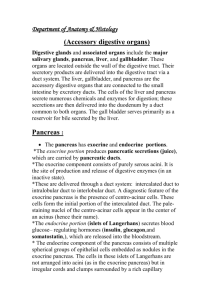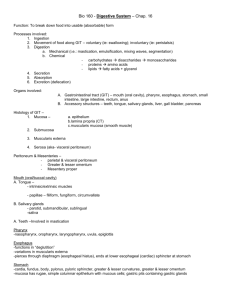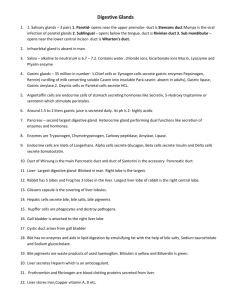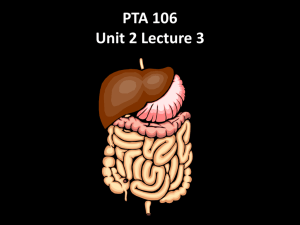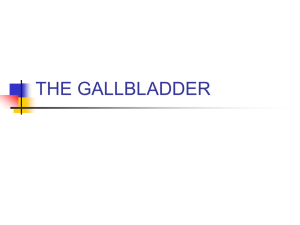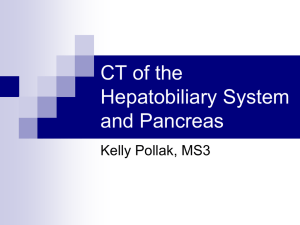The Liver 肝
advertisement
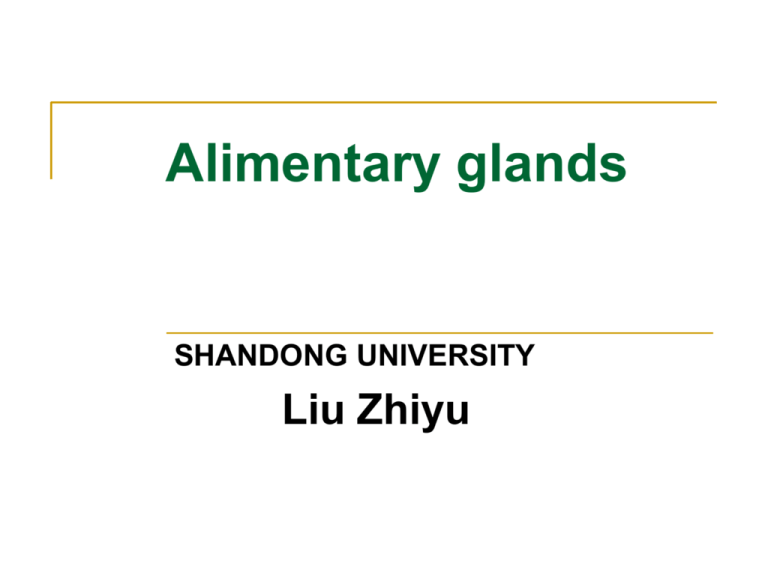
Alimentary glands SHANDONG UNIVERSITY Liu Zhiyu The Liver Shape -two surfaces Diaphragmatic surface Convex and smooth Divided into right and left lobes by falciform lig. of liver Visceral surface The Liver Visceral surface -has a Hshaped fissures and grooves Cross-bar of H — porta hepatis Traversed by Right and left hepatic ducts Left and right branches of proper hepatic artery and hepatic portal vein Nerves and lymphatic vessels These structures which are surrounded by connective tissue called hepatic pedicle Four lobes: left, right, quadrate and caudate lobes The Liver Left limb of H Anteriorly: fissure for ligamentum teres hepatis Posteriorly: fissure for ligamentum venosum Right limb of H Anteriorly: fossa for gallbladder Posteriorly: Sulcus for vena cava Secondary porta of live The Liver 肝 Inferior border –thin and sharp Notch for ligamentum teres hepatis Nothch for gallbladder The Liver Position: Most of liver lies in the right hypochondriac region and epigastric region less part extending into the left hypochondriac region The Liver Surface projection Upper border: on the right midclavicular line it extends the level of 5th rib The Liver Surface projection Lower border: Normally, the right lobe extends just beneath the costal margin, it doesn’t down beyond the costal margin; on the anterior median line its lower border crosses a point about 3~5cm below the xiphoid process. In children, the liver being larger in proportion to the body than in the adult stage, it extends below the costal arch within in 2cm. The Liver The segments of the liver The segmentation of the liver, bases upon the principal divisions of the proper hepatic artery and accompanying hepatic ducts and hepatic portal vein-Glisson system. The hepatic veins, however do not follow the same pattern and vary: their main tributaries tend to run rather intersegmental. Gallbladder Position : lies in fossa for gallbladder on visceral surface of liver Four parts Fundus of gallbladder Surface projection: at the junction of right midclavicular line and right costal arch Body of gallbladder Neck of gallbladder Cystic duct Function: stores and concentrate bile Extrahepatic Biliary Apparatus Consists of Gallbladder Left and right hepatic ducts Common hepatic duct Common bile duct Biliary duct system Left and right hepatic ducts unite outside of liver to form the common hepatic duct Cystic duct joins common hepatic duct to form common bile duct Biliary duct system Hepatopancreatic ampulla (ampulla of Vater) Common bile duct and pancreatic duct run obliquely through the wall of the descending part of duodenum where the two ducts usually unite to form the hepatopancreatic ampulla Which rounded by sphincter of hepatopancreatic ampulla (sphincter of Oddi), each has an independent sphincteric mechanism for regulating flow, and opens at the major duodenal papilla Bile is secreted by the liver cells Common hepatic duct Biliary ductuli Cystic duct Right and left hepatic ducts Gallbladder (store, concentrate) when the fat enters the small intestine, the gallbladder contracts, the sphincter of hepatopancreatic ampulla relax Common bile duct Major duodenal papilla Duodenal cavity Extrahepatic Biliary Apparatus The Pancreas Shape and Position A soft yellowish lobulated gland Lies behind the peritoneum on the posterior abdominal wall, roughly at the level of of L1~L2 The Pancreas Four parts Head Lies within the cancavity of the Cshaped curvatune of duodenum Uncinate process- a projection to the left from the lower part of the head behind the superior mesenteric vessels. Neck-narrow part, overlies the superior mesenteric vessels and beginning of the portal vein Body-triangular in cross section, passes upward ang to the left across the midline Tail-extends to the hilum of spleen in the splenorenal ligament Cystohepatic triangle (Calot’s Triangle) Boundaries Common hepatic duct on the left Cystic duct on the right Live superiorily Content: cystic artery The Pancreas Pancreatic duct Main Pancreatic duct Begins at tail and throughout gland Joins common bile duct before entering descending part of duodenum at major duodenal papilla Accessory pancreatic duct Opens 2cm above main duct at lesser duodenal papilla The Pancreas Function The pancreas is both an exocrine and an endocrine gland. The exocrine portion of the gland produces a secretion that contains enzymes that are capable of hydrolyzing proteins, fats, and carbohydrates. The endocrine portion of the gland, the pancreatic islet, produces the hormones insulin and glucagons that play a key role in carbohydrate metabolism.

